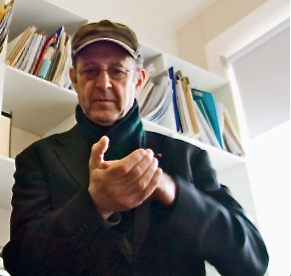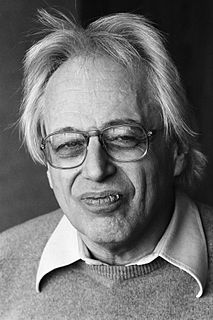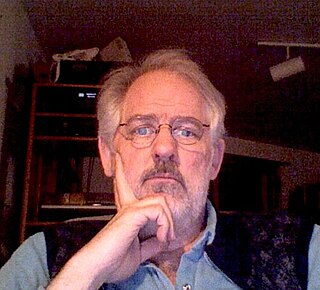Related Research Articles

Stephen Michael Reich is an American composer known for his contribution to the development of minimal music in the mid to late 1960s.

Samuel Conlon Nancarrow was an American-born composer who lived and worked in Mexico for most of his life. He became a Mexican citizen in 1956.

György Sándor Ligeti was a Hungarian-Austrian composer of contemporary classical music. He has been described as "one of the most important avant-garde composers in the latter half of the twentieth century" and "one of the most innovative and influential among progressive figures of his time".

In C is a musical piece composed by Terry Riley in 1964 for an indefinite number of performers. He suggests "a group of about 35 is desired if possible but smaller or larger groups will work". A series of short melodic fragments, In C is often cited as the first minimalist composition.
William Duckworth was an American composer, author, educator, and Internet pioneer. He wrote more than 200 pieces of music and is credited with the composition of the first postminimal piece of music, The Time Curve Preludes (1977–78), for piano. Duckworth was a Professor of Music at Bucknell University. Together with Nora Farrell, his wife, he ran Monroe Street Music, the publisher of many Duckworth's pieces.

Process music is music that arises from a process. It may make that process audible to the listener, or the process may be concealed.

Kyle Eugene Gann is an American professor of music, critic, analyst, and composer who has worked primarily in the New York City area. As a music critic for The Village Voice and other publications, he has supported progressive music, including such "downtown" movements as postminimalism and totalism.
Tom Johnson, is an American minimalist composer, a former student of Morton Feldman.

Downtown music is a subdivision of American music, closely related to experimental music, which developed in downtown Manhattan in the 1960s.
Minimal music is a form of art music or other compositional practice that employs limited or minimal musical materials. Prominent features of minimalist music include repetitive patterns or pulses, steady drones, consonant harmony, and reiteration of musical phrases or smaller units. It may include features such as phase shifting, resulting in what is termed phase music, or process techniques that follow strict rules, usually described as process music. The approach is marked by a non-narrative, non-teleological, and non-representational approach, and calls attention to the activity of listening by focusing on the internal processes of the music.
Totalism is a style of art music that arose in the 1980s and 1990s as a response to minimalism. It paralleled postminimalism but involved a younger generation of creators, born in the 1950s. This term, invented by writer and composer Kyle Gann, has not been adopted by contemporary musicology and generally still refers only to Gann’s use of it in his writings.

Connotations is a classical music composition for symphony orchestra written by American composer Aaron Copland. Commissioned by Leonard Bernstein in 1962 to commemorate the opening of Philharmonic Hall in New York City, United States, this piece marks a departure from Copland's populist period, which began with El Salón México in 1936 and includes the works he is most famous for such as Appalachian Spring, Lincoln Portrait and Rodeo. It represents a return to a more dissonant style of composition in which Copland wrote from the end of his studies with French pedagogue Nadia Boulanger and return from Europe in 1924 until the Great Depression. It was also Copland's first dodecaphonic work for orchestra, a style he had disparaged until he heard the music of French composer Pierre Boulez and adapted the method for himself in his Piano Quartet of 1950. While the composer had produced other orchestral works contemporary to Connotations, it was his first purely symphonic work since his Third Symphony, written in 1947.
Petr Kotik is a composer, conductor and flutist living in New York City. He was educated in Europe. From 1960 to 1963, Kotik studied composition privately with Jan Rychlík in Prague, and from 1963 to 1966 at the Music Academy in Vienna with Karl Schieske, Hans Jelinek, and Friedrich Cerha. In Prague, he founded and directed Musica Viva Pragensis (1961–64) and the QUAX Ensemble (1966–69). He came to the United States in 1969 at the invitation of Lukas Foss and Lejaren Hiller to join the Center for Creative and Performing Arts at the University at Buffalo.

The Well-Tuned Piano is an ongoing, improvisatory, solo piano work by composer La Monte Young. Begun in 1964, Young has never considered the composition or performance "finished", and he has performed incarnations of it several times since its debut in 1974. The composition utilizes a piano tuned in just intonation.

Phase music is a form of music that uses phasing as a primary compositional process. It is an approach to musical composition that is often associated with minimal music, as it shares similar characteristics, but some commentators prefer to treat phase music as a separate category. Phasing is a compositional technique in which the same part is played on two musical instruments, in steady but not identical tempi. Thus, the two instruments gradually shift out of unison, creating first a slight echo as one instrument plays a little behind the other, then a doubling effect with each note heard twice, then a complex ringing effect, and eventually coming back through doubling and echo into unison. Phasing is the rhythmic equivalent of cycling through the phase of two waveforms as in phasing. Note that the tempi of the two instruments are almost identical, so that both parts are perceived as being in the same tempo: the changes only separate the parts gradually. In some cases, especially live performance where gradual separation is extremely difficult, phasing is accomplished by periodically inserting an extra note into the phrase of one of the two players playing the same repeated phrase, thus shifting the phase by a single beat at a time, rather than gradually.

Irritable Hedgehog Music is a Kansas City-based record label, focused primarily on minimalist music and electroacoustic music.
R. Andrew Lee is an American pianist of contemporary classical music, with a particular emphasis on Minimal music and music of the Wandelweiser collective. He has recorded ten albums for Irritable Hedgehog Music.
Nyx is a symphonic poem by the Finnish composer Esa-Pekka Salonen. The work was jointly commissioned by Radio France, the Barbican Centre, the Atlanta Symphony Orchestra, Carnegie Hall, and the Finnish Broadcasting Company. It was premiered February 19, 2011 in the Théâtre du Châtelet, Paris, with Salonen conducting the Orchestre Philharmonique de Radio France. The piece is titled after the Goddess Nyx from Greek mythology.
The Time Curve Preludes is a minimalist composition for piano solo by William Duckworth written between 1977 and 1978. This piece is credited as the first postminimal piece of music, and it is his most frequently heard work. The Time Curve Preludes were composed between 1977 and 1978 on a fellowship from the National Endowment for the Arts. They were premiered at Wesleyan University in 1979 by pianist Neely Bruce. Duckworth used elements of Minimalism, including repetition and accessible harmonies, yet also embraced more quickly changing structures; wide-ranging, complex melodies; and colorful dissonances.
Dennis Lee Johnson was a mathematician and a composer. He is the namesake of the Johnson homomorphism in the study of mapping class groups of surfaces. He is credited as having composed the first truly "minimal" composition November, which was written for solo piano in 1959.
References
- ↑ Editions75
- ↑ An Hour for Piano streamed online, performed by R. Andrew Lee.
- ↑ Sixty Minutes to Change Your Life, by Kyle Gann.
- ↑ Tom Johnson's Program Notes [ permanent dead link ]
- ↑ The Voice of New Music, available free as a PDF
- ↑ S. Andrew Granade's Liner Notes [ permanent dead link ]